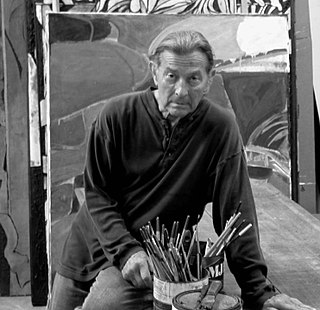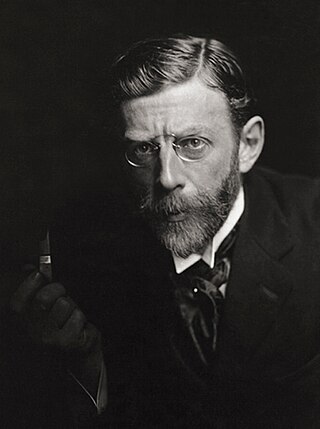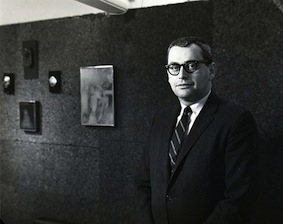Related Research Articles

Stanton Macdonald-Wright, was a modern American artist. He was a co-founder of Synchromism, an early abstract, color-based mode of painting, which was the first American avant-garde art movement to receive international attention.

Lenore "Lee" Krasner was an American painter and visual artist active primarily in New York whose work has been associated with the Abstract Expressionist movement. She received her early academic training at the Women's Art School of Cooper Union, and the National Academy of Design from 1928 to 1932. Krasner's exposure to Post-Impressionism at the newly opened Museum of Modern Art in 1929 led to a sustained interest in modern art. In 1937, she enrolled in classes taught by Hans Hofmann, which led her to integrate influences of Cubism into her paintings. During the Great Depression, Krasner joined the Works Progress Administration's Federal Art Project, transitioning to war propaganda artworks during the War Services era.
Wallace "Wally" Berman was an American experimental filmmaker, assemblage, and collage artist and a crucial figure in the history of post-war California art.

Donald Jess Bachardy is an American portrait artist. He resides in Santa Monica, California. Bachardy was the partner of Christopher Isherwood for over 30 years.
Barbara Kruger is an American conceptual artist and collagist associated with the Pictures Generation. She is most known for her collage style that consists of black-and-white photographs, overlaid with declarative captions, stated in white-on-red Futura Bold Oblique or Helvetica Ultra Condensed text. The phrases in her works often include pronouns such as "you", "your", "I", "we", and "they", addressing cultural constructions of power, identity, consumerism, and sexuality. Kruger's artistic mediums include photography, sculpture, graphic design, architecture, as well as video and audio installations.

Mary Doretta Heebner is an American artist and author.
Roy De Forest was an American painter, sculptor, and teacher. He was involved in both the Funk art and Nut art movements in the Bay Area of California. De Forest's art is known for its quirky and comical fantasy lands filled with bright colors and creatures, most commonly dogs.

Grant Mudford, is an Australian photographer.
Irwin Kremen was an American artist who began making art while Director of the Duke University Graduate Program in Clinical Psychology, when he was 41, after earning a PhD six years earlier in clinical psychology at Harvard University.

Colin Campbell Cooper, Jr. was an American impressionist painter of architectural paintings, especially of skyscrapers in New York City, Philadelphia, and Chicago. An avid traveler, he was also known for his paintings of European and Asian landmarks, as well as natural landscapes, portraits, florals, and interiors. In addition to being a painter, he was also a teacher and writer. His first wife, Emma Lampert Cooper, was also a highly regarded painter.

James Jarvaise was an American painter based in Southern California.
Craig Kauffman was an artist who has exhibited since 1951. Kauffman's primarily abstract paintings and wall relief sculptures are included in over 20 museum collections, including the Museum of Modern Art, the Whitney Museum of American Art, the Tate Modern, the Louisiana Museum of Modern Art, the Art Institute of Chicago, the Los Angeles County Museum of Art, Seattle Art Museum, and the Museum of Contemporary Art, Los Angeles.

Leon Dabo was an American tonalist landscape artist best known for his paintings of New York State, particularly the Hudson Valley. His paintings were known for their feeling of spaciousness, with large areas of the canvas that had little but land, sea, or clouds. During his peak, he was considered a master of his art, earning praise from John Spargo, Bliss Carman, Benjamin De Casseres, Edwin Markham, and Anatole Le Braz. His brother, Scott Dabo, was also a noted painter.

Felix Henry Landau was an American art dealer whose Los Angeles gallery was a showcase for modern and contemporary art in the 1960s.
William Theophilus Brown was an American artist. He became prominent as a member of the Bay Area Figurative Movement.

John Dwyer McLaughlin was an American abstract painter. Based primarily in California, he was a pioneer in minimalism and hard-edge painting. Considered one of the most significant Californian postwar artists, McLaughlin painted a focused body of geometric works that are completely devoid of any connection to everyday experience and objects, inspired by the Japanese notion of the void. He aimed to create paintings devoid of any object hood including but not limited to a gestures, representations and figuration. This led him to the rectangle. Leveraging a technique of layering rectangular bars on adjacent planes, McLaughlin creates works that provoke introspection and, consequently, a greater understanding of one's relationship to nature.
Edward Corbett was an American Abstract Expressionist artist.

Anthony Hanna Berlant is an American artist who was born in New York City. He attended the University of California, Los Angeles, where he received a BA (1961) and MA (1962) in painting and an MFA (1963) in sculpture. He has a large collection of Southwestern Native American art, especially Mimbres pottery and Navajo rugs. He lives and works in Santa Monica, California.

Norman Charles Zammitt was an American artist in Southern California who was at the leading edge of the Light and Space Movement, pioneering with his transparent sculptures in the early 1960s, followed in the 1970s by his large scale luminous color paintings.
Clarence Keiser Hinkle, was an American painter and art educator. His art studio was in Laguna Beach, California, and later in Santa Barbara, California. He was known for his still life and portrait paintings.
References
- 1 2 3 4 John Russell (January 15, 1983). "WILLIAM DOLE, 65, AN ARTIST WHO WAS KNOWN FOR COLLAGES". The New York Times .
- 1 2 3 4 5 6 7 8 "William Dole (1917-1983)". Sullivan Goss.
- 1 2 3 "Dole (William) papers". Online Archive of California. September 13, 2014.
- ↑ "William Earl Dole, Jr., Art: Santa Barbara". Online Archive of California. 1985.
- ↑ "Cut and Paste: Collage in Santa Barbara". Kolaj Magazine.
- 1 2 Josef Woodard (April 9, 1992). "EXHIBIT : The Essence of Dole : A display of collage works by the famous Santa Barbara artist chronicles the evolution of his unique talent". Los Angeles Times .
- ↑ Ronny Cohen (February 1985). "William Dole". Artforum .
- ↑ Charles Donelan (January 1, 2019). "'Cut and Paste' at The Arts Fund". Santa Barbara Independent.
- ↑ John Russell (December 14, 1974). "Art: Fragments of Language That Delight the Eyes". New York Times.
- ↑ John Russell (November 12, 1976). "Art: New Collages By William Dole". New York Times.
- ↑ John Russell (December 5, 1982). "CRITICS' CHOICES; ART". New York Times.
- ↑ Muchnic, Suzanne (March 5, 2003). "Felix Landau, 78; His L.A. Art Gallery Was Showcase in 1960s". Los Angeles Times.
- ↑ Ward, Cynthia Carbone (February 26, 2024). "When Khrushchev Came to Gaviota". The Santa Barbara Independent. Retrieved March 1, 2024.
- ↑ ""Kathryn Lee Holcomb Dole"". Santa Barbara Independent. January 6, 2012.